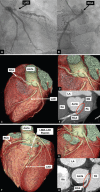Diagnosis and Management of Anomalous Coronary Arteries with a Malignant Course
- PMID: 31178934
- PMCID: PMC6545977
- DOI: 10.15420/icr.2019.1.1
Diagnosis and Management of Anomalous Coronary Arteries with a Malignant Course
Abstract
Although the prevalence of anomalous coronary artery from the opposite sinus (ACAOS) in the general population is low, more frequent use of invasive and non-invasive imaging to rule out coronary artery disease has seen an increase in absolute numbers of ACAOS. ACAOS are traditionally classified as malignant (with an interarterial course) and benign variants. Malignant variants have been recognised in autopsy studies to be an underlying cause of sudden cardiac death in young athletes. Conversely, it seems that older people with ACAOS are less predisposed to adverse cardiac events. Non-invasive anatomic imaging is complementary to invasive imaging and helps to further identify high-risk anatomic features. Using functional non-invasive perfusion imaging can assess potential ischaemia induced by dynamic compression of malignant ACAOS. Information gained from clinical imaging guides the management of these patients.
Keywords: Anomalous coronary artery from the opposite sinus of Valsalva; coronary artery anomaly; non-invasive imaging; sudden cardiac death.
Conflict of interest statement
Disclosure: The authors have no conflicts of interest to declare.
Figures
References
Publication types
LinkOut - more resources
Full Text Sources




